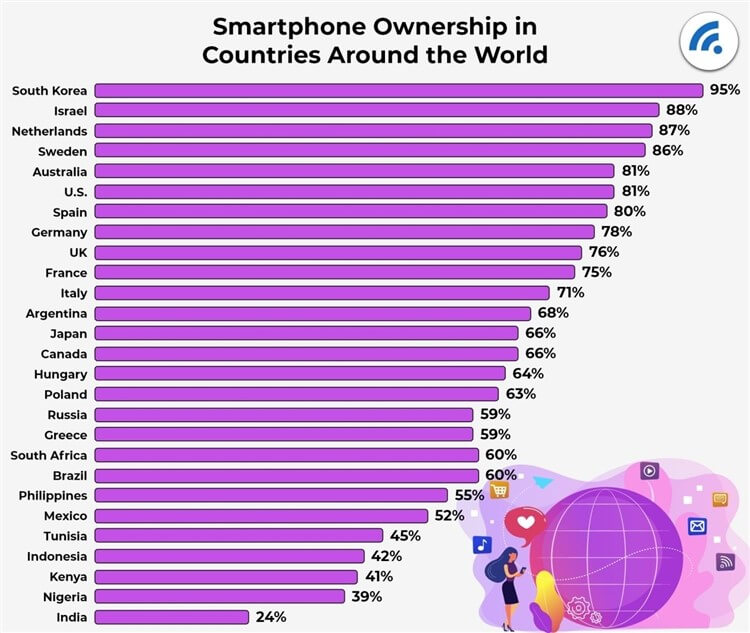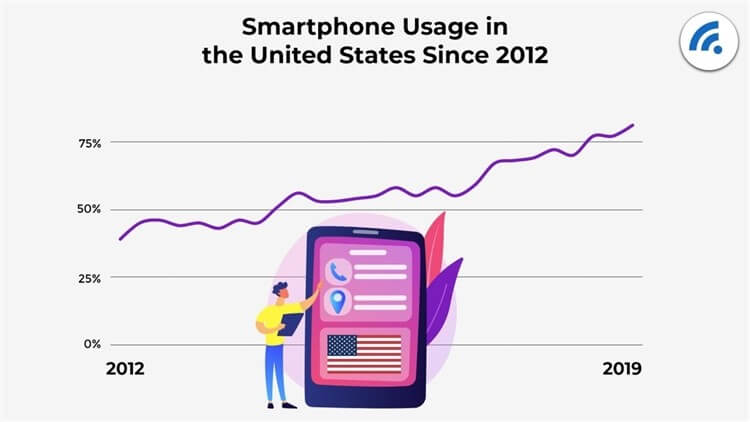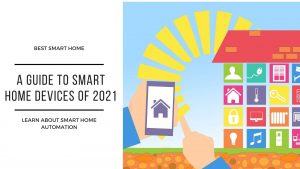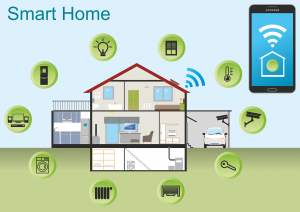Smartphones have become a part of people’s daily lives. Many people can’t live without their phones or they feel disconnected from the world.
What’s the growing trend of smartphone usage? Is the distribution comparable across the globe? What functions are available through smartphones, other than access to the information? And these questions will be listed in this article.
Global smartphone usage
3.5 billion smartphone users worldwide
Smartphones only started to enter the market 10-15 years ago, and today half of the world’s 7 billion people (including children) own smartphones. As the chart below shows, the number of smartphone users is growing.

The median smartphone ownership in rich countries is 76%, while in less developed countries the median is only 45%.
The following is a summary of smartphone ownership in rich and developing countries.
As the chart shows, the proportion of people with smartphones is much higher in more prosperous countries than in less developed countries. But there is also a wealth gap in wealthier countries.
Since the economic crisis in 2008, the Greek economy has not been able to get out of the woods, and its income is much lower than the rest of Europe, which may be why only 59% of the population in Greece has a smartphone. India’s value reflects its large rural population, which tends to be poorer and has less access to these technology products.
In all countries, the percentage varies widely between older and younger groups. For example, 97% of young people in Australia own a smartphone, compared to 68% of the older group. The percentages are 98% and 48% in Italy (48% is lower than in most countries).
This gap is even wider in emerging market countries, such as Brazil, where 85% of young people own a smartphone compared to 32% of the older and the Philippines, where 74% of young people own a smartphone compared to 27% of the older group.
In these countries, younger generations tend to have access to higher-paying jobs and receive more appropriate work environment training. In addition, young people are more likely to access social media and other applications that drive smartphone use. In the long run, smartphone ownership in developing countries worldwide will soon catch up with wealthier nations.
50.3% of global Internet traffic occurs on smartphones
With only 16.2% of global Internet traffic share in 2013, mobile Internet traffic has more than tripled in the last seven years. There are many reasons for this, mainly due to the increased popularity of smartphones and improved mobile networks. This growth trend is now gradually leveling off, with mobile traffic’s share at 52.2% in 2018 and 53.3% in 2019. The slowing trend is expected to break through with the onslaught of 5G networks and devices, which people will rely on more than ever.
There are currently more than 10 billion mobile devices in use worldwide. It means that everyone has more than one cell phone. It is a slightly strange statistic, but when you think about it, many people will use multiple phones to differentiate between work and life. This statistic also takes tablets into account.
Of course, due to income differences, ownership of multiple devices is more likely to occur in wealthy countries. But on average, each person in the world (including adults and children) owns an average of 1.42 mobile devices, which is still an incredible number.
Smartphone use in the U.S.
81% of Americans own a smartphone

In 2020, more than 3/4 of Americans will own a smartphone, but this is a relatively new trend. In 2011, only 35 percent of Americans owned a smartphone. With more smartphone options, improved network infrastructure, and many must-have apps coming online, smartphones are becoming almost a necessity.
Factors influencing smartphone use
According to Pew, 82 percent of whites, 80 percent of blacks and 79 percent of Latinos own smartphones, indicating that race does not influence smartphone use. However, education and income level is a clear indicator of influence.
Only 66% of those with less than a high school education own a smartphone, while 91% of college graduates own smartphones.
This trend’s suggests that groups with less than a high school education have less access to economic opportunities. Those with a college education are more likely to get a job and enter a social circle where smartphones are necessary.
The effect of income level is not as significant as one might think. The numbers in the chart indicate that the higher the income, the greater the likelihood of having a smartphone. But all people earning less than $30,000 are lumped together. A person earning $28,000 might afford a phone, especially now that there is an option to pay for it in installments. However, someone who also makes $25,000 and has to take care of children may not afford it.
Understanding the differences within this group helps to understand better what these numbers mean, namely that income (influenced in part by education) is the biggest influence on smartphone purchases in the United States.
Uses of smartphones
As more and more apps become available, people tend to use apps to access the Internet because of their convenience and ease of use.
At the same time, people are turning to smartphones for shopping. Online shopping (e-commerce) has continued to grow significantly over the past few years. More and more people use their cell phones to find products, read reviews, and make purchases. Mobile e-commerce sales have now reached $3.56 billion, much higher than the $1 billion in 2016.
In the U.S., mobile conversion rates are only 1.53%, compared to 4.14% for desktop computers. As more mobile apps come online and smartphone usage continues to grow, people will rely more on their phones for shopping.
The popularity of smartphones also promotes the development of smart homes. The use of smartphones is no longer limited to getting information, shopping and other functions. With the improvement of smartphone performance and the development of the mobile internet, smartphones have become an indispensable part of people’s lives. They will become the mainstream control terminal of the smart home control system in the future.
The role of smartphone in smart home
One app on a smartphone can directly control all furniture and home appliances. Whether it is the intelligent linkage of multiple devices such as lights, curtains, air conditioners, fans, music, or real-time monitoring of environmental changes at home, users can set up scenes according to their own needs and realize all controls through one APP their smartphones.
Take the LED controller as an example. After the controller is connected to the smartphone, the smartphone acts as the operation interface. It sends the operation command to the cloud system, which is then transmitted to the LED strip lights controller through the cloud system and controls the light strip accordingly.
You can make different operations on the smartphone, such as adjusting the color and brightness, scenario mode, timer switch, etc.
In addition, when you are in the office, you can also control the lights at home through your smartphone to achieve a remote control function.
With the advent of the 5G era, 5G smartphones are the future trend of terminal control systems. 5G smartphones can achieve ultra-fast data transfer rates and low latency characteristics, using them as the absolute control core for remote control of smart home devices. At the same time, it can carry out online monitoring with almost no delay and retrieve the control authority after the user leaves the house to avoid the use of smart home devices after the home is illegally invaded. When there are visitors in the home, It can be established via a 5G smartphone of a temporary connection.
The permission is assigned to some smart home devices after the user’s authentication and authorization. The visitor’s 5G smartphone can act as a temporary remote control to use the smart home devices with open permission. It dramatically improves the convenience and security of smart home control and provides a better user experience and comfort for users.
Related Articles




